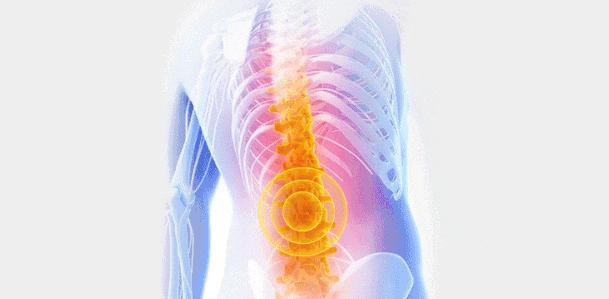"Everyone has a lumbar disc, why is yours so prominent?" In the ridicule of modern people, lumbar disc herniation has been widely recognized.
Human beings have long been plagued by the pain of the waist and legs caused by lumbar protrusion, but in history, people's understanding of it has taken many detours.

Experts interviewed
School of Medical Humanities, Capital Medical University, Kong Feile, □ Gu Xiaoyang
Zhu Bin, deputy chief physician of the Department of Orthopedics, Beijing Friendship Hospital, Capital Medical University
The lumbar process was once considered a tumor
The ancients noticed low back and leg pain and lower limb pain early on, and listed many causes other than exertion.
The "Yellow Emperor's Internal Classic" once put forward, "The waist is the house of the kidney, it can't be shaken, the kidney will be exhausted, the veins of the hengluo make the waist pain, you can't pitch, and if you lean up, you will be afraid of the servant, and you will have to lift it heavily and hurt the waist";
The ancient Celts believed that trick-or-treating elves shot people in the waist with arrows to cause pain;
Hippocrates, a famous ancient Greek physician, observed that some patients had lameness due to pain and its relationship with the sciatic nerve, and proposed that massage, heat therapy, bed rest and other methods could be used to relieve it.
Spinal traction in the Hippocrates period
In 1908, neuropathologist Hermann Oppenheim published a paper showing that the uneven material in the spinal canal was a new tumor born of bone, which was later called "neuraxial endogenic chondroma". For a long time to come, the idea that lumbar protrusion was a tumor was perpetuated.
It was not until 1929 that American neurosurgeon Walter Dandy determined that the "tumor tissue" removed from the patient's spinal canal was cartilage fragments and not real tumors.
In 1934, American neurosurgeon William Jason Mister and orthopedic surgeon Joseph Barr published a paper in the New England Journal of Medicine.
The paper details that the protrusion of the nucleus pulposus into the spinal canal, or disc rupture, is a very common condition that can be treated with surgery. At this point, the clinical understanding of lumbar protrusion is on track.
A test to determine whether there is a lumbar process
In 1864, French neurologist Ernest Charles Lasseg noticed the relationship between low back pain and the sciatic nerve, and proposed a physical examination method for sciatica, which is the lumbar process examination widely used today - straight leg elevation test.
Ordinary people can preliminarily judge whether there is a lumbar protrusion through the straight leg elevation test without going to the hospital.
Method: Lie on your back with your legs straight, and the examiner holds the patient's knee with one hand to straighten the knee joint. Hold the ankle with the other hand and slowly raise the leg until the patient develops radiating pain in the lower extremity. Record the angle of the lower limbs to the bed at this time.
If you do not feel discomfort to 60 ° ~ 70 °, it is likely not a lumbar process;
If the elevation is within 60°, the sciatic nerve (the back of the thigh, the posterolateral calf and the foot) is too painful, and it can basically be judged as a lumbar process.
Lumbar protrusion, the important thing is prevention
After lumbar spine degeneration and aging or experiencing inappropriate movement and external forces, a "bulge" may be ejected behind the lumbar disc.
If it is pressed on the nerve root, it will cause symptoms such as low back pain, leg pain, leg numbness, weakness, etc., that is, lumbar disc herniation.
80% of lumbar disc herniations can be relieved by physiotherapy, traction, lying still, and medication. Patients with severe conditions such as hypoesthesia and urinary and urinary dysfunction require surgery.
Massage + warm compress
Mild muscle spasms or pain caused by lumbar disc herniation can be relieved by manual massage and warm compresses.
Massage needs to be performed under the premise of a clear diagnosis by MRI, and cannot be massaged blindly.
Traction therapy
Traction therapy can slightly increase the intervertebral space, reduce the pressure in the intervertebral disc, and expand the capacity of the spinal canal, thereby reducing irritation or compression of the nerve roots.
Bed rest
When lying flat, the pressure on the lumbar spine is minimal, and the symptoms may gradually ease. Generally, it is necessary to stay in bed for 3 weeks, get up with a waist circumference after 3 weeks, and do not bend over and hold objects for 3 months.
With medication
Physiotherapy can be accompanied by medication. Commonly used are non-steroidal anti-inflammatory painkillers, which eliminate pain by eliminating inflammatory factors.
Muscle relaxants, neurotrophic drugs, etc. have an effect on the symptoms of intervertebral disc herniation and need to be used as directed by a doctor.
Treatment for lumbar protrusion varies from person to person. If treatment does not resolve for more than six weeks to more than three months, a doctor should be asked to assess the need for surgery.
Although the treatment of lumbar syndrome is evolving rapidly, the best treatment is prevention. Regardless of the type of lumbar spine disease, the prevention methods are similar:
▶ Maintain proper posture and avoid sitting, standing, and lying down for a long time. Pay attention to the combination of work and rest when working, and avoid watching TV and reading books on a high pillow and nestled in bed when lying in bed.
▶ Targeted exercise of low back muscles, such as Xiaoyanfei, hip bridge, five-point support, etc.
▶ Exercise moderately, but avoid extreme impact, rotation and flexion of the waist.
▶ Choose a mattress with moderate soft and hard, so that it is most suitable to lie on it without obvious sagging waist. ▲
Editor of this issue: Yang Meng